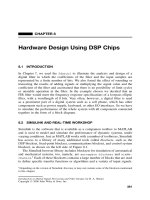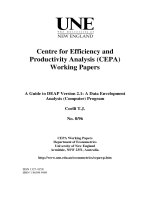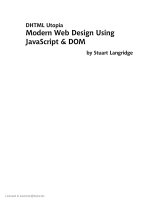rtl hardware design using vhdl coding for efficiency, portability, and scalability
Bạn đang xem bản rút gọn của tài liệu. Xem và tải ngay bản đầy đủ của tài liệu tại đây (34.11 MB, 696 trang )
~
~~ ~~ ~ ~
RTL
HARDWARE
DESIGN
USING
VHDL
Coding
for
Efficiency, Portability,
and
Scalability
PONG
P.
CHU
Cleveland State University
A JOHN
WlLEY
&
SONS, INC., PUBLICATION
This Page Intentionally Left Blank
RTL
HARDWARE DESIGN
USING
VHDL
This Page Intentionally Left Blank
~
~~ ~~ ~ ~
RTL
HARDWARE
DESIGN
USING
VHDL
Coding
for
Efficiency, Portability,
and
Scalability
PONG
P.
CHU
Cleveland State University
A JOHN
WlLEY
&
SONS, INC., PUBLICATION
Copyright
0
2006 by John Wiley
&
Sons, Inc. All rights reserved.
Published by John Wiley
&
Sons, Inc., Hoboken, New Jersey.
Published simultaneously in Canada.
No
part of this publication may be reproduced, stored
in
a retrieval system, or transmitted in any form
or
by any means, electronic, mechanical, photocopying, recording, scanning, or otherwise, except as
permitted under Section 107 or 108 of the 1976 United States Copyright Act, without either the prior
written permission of the Publisher, or authorization through payment of the appropriate per-copy fee to
the Copyright Clearance Center, Inc., 222 Rosewood Drive, Danvers,
MA 01923, (978) 750-8400, fax
(978) 750-4470, or on the web at www.copyright.com. Requests to the Publisher for permission should
be addressed to the Permissions Department, John Wiley
&
Sons, Inc.,
1
11 River Street, Hoboken, NJ
07030, (201) 748-601 1, fax (201) 748-6008, or online at
Limit of LiabilityiDisclaimer of Warranty: While the publisher and author have used their best efforts in
preparing this
book,
they make no representations or warranties with respect to the accuracy or
completeness of the contents of
this
book and specifically disclaim any implied warranties of
merchantability or fitness for a particular purpose.
No
warranty may be created or extended by sales
representatives or written sales materials. The advice and strategies contained herein may not
be
suitable for your situation.
You
should consult with a professional where appropriate. Neither the
publisher nor author shall be liable for any loss of profit or any other commercial damages, including
but not limited
to
special, incidental, consequential,
or
other damages.
For general information on
OUT
other products and services or for technical support, please contact
OUT
Customer Care Department within the United States at (800) 762-2974, outside the United States at
(317) 572-3993 or fax (317) 572-4002.
Wiley also publishes its books in a variety of electronic formats. Some content that appears
in
print may
not be available
in
electronic format. For information about Wiley products, visit our web site at
www.wiley.com.
Library
of
Congress Cataloging-in-Publication Data:
Chu, Pong P., 1959-
p. cm.
RTL hardware design using VHDL
I
by Pong P. Chu.
Includes bibliographical references and index.
“A Wiley-Interscience publication.”
ISBN-13: 978-0-471-72092-8 (alk. paper)
ISBN-10: 0-471-72092-5 (alk. paper)
1. Digital electronics-Data processing. 2. VHDL (Computer hardware description
language).
I.
Title.
TK7868.D5C46 2006
621.39‘2-4~22
Printed in the United States of America.
2005054234
10987654321
To
my
parents Chia-Chi and Chi-Te,
my
wife Lee, and
my
daughter Patricia
This Page Intentionally Left Blank
CONTENTS
Preface
Acknowledgments
1
Introduction to Digital System Design
1.1
Introduction
1.2 Device technologies
1.2.1 Fabrication of an IC
1.2.2 Classification of device technologies
1.2.3 Comparison of technologies
1.3 System representation
1.4
Levels of Abstraction
1.4.1 Transistor-level abstraction
1.4.2 Gate-level abstraction
1.4.3 Register-transfer-level (RT-level) abstraction
1.4.4 Processor-level abstraction
Development tasks and EDA software
1.5.1 Synthesis
1
S.2 Physical design
1
S.3 Verification
1
S.4 Testing
1.5.5
1.5
EDA software and its limitations
xix
xxiii
1
1
2
2
2
5
8
9
10
10
11
12
12
13
14
14
16
16
vil
V\i\
CONTENTS
1.6
Development flow
1.6.1
1.6.2
1.6.3
1.7
Overview
of
the book
1.7.1
Scope
1.7.2
Goal
1.8
Bibliographic notes
Problems
Flow
of
a medium-sized design targeting FPGA
Flow
of
a large design targeting FPGA
Flow of a large design targeting ASIC
2 Overview
of
Hardware Description Languages
2.1
Hardware description languages
Limitations of traditional programming languages
Use of
an
HDL program
Design
of
a modem HDL
2.1.1
2.1.2
2.1.3
2.1.4
VHDL
Basic VHDL concept via
an
example
2.2.1
General description
2.2.2
Structural description
2.2.3
Abstract behavioral description
2.2.4
Testbench
2.2.5
Configuration
2.3
VHDL in development flow
2.3.1
Scope of VHDL
2.3.2
Coding
for
synthesis
Problems
2.2
2.4
Bibliographic notes
3 Basic Language Constructs
of
VHDL
3.1
Introduction
3.2
Skeleton
of
a basic VHDL program
3.2.1
3.2.2
Entity declaration
3.2.3
Architecture body
3.2.4
Design unit and library
3.2.5
Processing
of
VHDL code
Lexical elements and program format
3.3,l
Lexical elements
3.3.2
VHDL program format
Example
of
a VHDL program
3.3
3.4
Objects
3.5
Data types and operators
17
17
19
19
20
20
20
21
22
23
23
23
24
25
25
26
27
30
33
35
37
38
38
40
40
41
43
43
44
44
44
46
46
47
47
47
49
51
53
CONTENTS
IX
3.5.1
3.5.2
3.5.3
3.5.4
3.5.5
3.6.1
Guidelines for general VHDL
3.6.2
Guidelines for VHDL formatting
Problems
Predefined data types in VHDL
Data types in the
IEEE
stdlogic-1164 package
Operators over an array data type
Data types in the
IEEE
numeric-std package
The stdlogic-arith and related packages
3.6
Synthesis guidelines
3.7
Bibliographic notes
53
56
58
60
64
65
65
66
66
66
4
Concurrent Signal Assignment Statements
of
VHDL
69
4.1
Combinational versus sequential circuits
4.2
Simple signal assignment statement
4.2.1
Syntax and examples
4.2.2
Conceptual implementation
4.2.3
4.3
Conditional signal assignment statement
4.3.1
Syntax and examples
4.3.2
Conceptual implementation
4.3.3
Detailed implementation examples
4.4.1
Syntax and examples
4.4.2
Conceptual implementation
4.4.3
Detailed implementation examples
Conditional signal assignment statement versus selected signal assignment
statement
4.5.1
4.5.2
Signal assignment statement with a closed feedback loop
4.4
Selected signal assignment statement
4.5
Conversion between conditional signal assignment and selected
signal assignment statements
Comparison between conditional signal assignment and selected
signal assignment statements
4.6
Synthesis guidelines
4.7
Bibliographic notes
Problems
5
Sequential Statements
of
VHDL
5.1.1
Introduction
5.1.2
5.1.3
5.1
VHDL process
Process with a sensitivity list
Process with a wait statement
5.2
Sequential signal assignment statement
69
70
70
70
71
72
72
76
78
85
85
88
90
93
93
94
95
95
95
97
97
97
98
99
100
X
CONTENTS
5.3
Variable assignment statement
5.4
If statement
5.4.1
Syntax and examples
5.4.2
5.4.3
5.4.4
Conceptual implementation
5.4.5
Cascading single-branched if statements
5.5.1
Syntax and examples
5.5.2
5.5.3
Incomplete signal assignment
5.5.4
Conceptual implementation
5.6.1
Syntax
5.6.2
Examples
5.6.3
Conceptual implementation
Comparison to a conditional signal assignment statement
Incomplete branch and incomplete signal assignment
5.5
Case statement
Comparison to a selected signal assignment statement
5.6
Simple
for
loop statement
5.7
Synthesis of sequential statements
5.8
Synthesis guidelines
5.8.1
5.8.2
Guidelines for combinational circuits
Problems
Guidelines for using sequential statements
5.9
Bibliographic notes
6
Synthesis
Of
VHDL
Code
6.1
Fundamental limitations of
EDA
software
6.1.1
Computability
6.1.2
Computation complexity
6.1.3
Limitations of
EDA
software
6.2.1
Realization of logical operators
6.2.2
Realization of relational operators
6.2.3
Realization of addition operators
6.2.4
6.2.5
6.2.6
An
example implementation
Realization of VHDL data types
6.3.1
6.3.2
6.3.3
6.4.1
RT-level synthesis
6.4.2
Module generator
6.2
Realization of VHDL operators
Synthesis support for other operators
Realization of an operator with constant operands
6.3
Use of the
std-logic
data type
Use and realization of the
’Z’
value
Use of the
’-’
value
6.4
VHDL synthesis flow
101
103
103
105
1
07
109
110
112
112
114
115
116
118
118
118
119
120
120
120
121
121
121
125
125
126
126
128
129
129
129
130
130
130
131
133
133
133
137
139
139
141
CONTENTS
Xi
6.4.3
Logic synthesis
6.4.4
Technology mapping
6.4.5
6.5.1
Propagation delay
6.5.2
Synthesis with timing constraints
6.5.3
Timing hazards
6.5.4
Effective use of synthesis software
6.5
Timing considerations
Delay-sensitive design and its dangers
6.6
Synthesis guidelines
6.7
Bibliographic notes
Problems
7
Combinational Circuit Design: Practice
Derivation of efficient
HDL
description
7.2.1
Sharing example
1
7.2.2
Sharing example
2
7.2.3
Sharing example
3
7.2.4
Sharing example
4
7.2.5
Summary
7.3.1
Addition-subtraction circuit
7.3.2
Signed-unsigned dual-mode comparator
7.3.3
Difference circuit
7.3.4
Full
comparator
7.3.5
Three-function barrel shifter
7.4.1
Reduced-xor circuit
7.4.2
Reduced-xor-vector circuit
7.4.3
Tree priority encoder
7.4.4
Barrel shifter revisited
7.5.1
Gray code incrementor
7.5.2
Programmable priority encoder
7.5.3
Signed addition with status
7.5.4
Combinational adder-based multiplier
7.5.5
Hamming distance circuit
7.1
7.2
Operator sharing
7.3
Functionality sharing
7.4
Layout-related circuits
7.5
General circuits
7.6
Synthesis guidelines
7.7
Bibliographic notes
Problems
142
143
148
149
150
154
156
158
160
160
160
163
163
164
165
166
168
169
170
170
171
173
175
177
178
180
181
183
187
192
196
196
199
20 1
203
206
208
208
208
8
Sequential Circuit Design: Principle
21
3
Xii
CONTENTS
8.1
8.2
8.3
8.4
8.5
8.6
8.7
8.8
8.9
Overview
of
sequential circuits
8.1.1
Sequential versus combinational circuits
8.1.2
Basic memory elements
8.1.3
Synchronous versus asynchronous circuits
Synchronous circuits
8.2.1
8.2.2
8.2.3
mes
of
synchronous circuits
Danger
of
synthesis that uses primitive gates
Inference
of
basic memory elements
8.4.1
D latch
8.4.2
DFF
8.4.3
Register
8.4.4
RAM
Simple design examples
8.5.1
Other types
of
FFs
8.5.2
Shift register
8.5.3
Arbitrary-sequence counter
8.5.4
Binary counter
8.5.5
Decade counter
8.5.6
Programmable mod-rn counter
Timing analysis
of
a synchronous sequential circuit
8.6.1
Synchronized versus unsynchronized input
8.6.2
Setup time violation and maximal clock rate
8.6.3
Hold time violation
8.6.4
Output-related timing considerations
8.6.5
Input-related timing considerations
Alternative one-segment coding style
8.7.1
Examples
of
one-segment code
8.7.2
Summary
Use
of
variables in sequential circuit description
Synthesis
of
sequential circuits
Basic model
of
a synchronous circuit
Synchronous circuits and design automation
8.10
Synthesis guidelines
8.1 1
Bibliographic notes
Problems
9 Sequential Circuit Design: Practice
9.1
Poor
design practices and their remedies
9.1.1
Misuse
of
asynchronous signals
9.1.2
Misuse
of
gated clocks
9.1.3
Misuse
of
derived clocks
9.2
Counters
213
213
214
216
217
217
218
219
219
221
22 1
222
225
225
226
226
229
232
233
236
237
239
239
240
243
243
244
245
245
250
250
253
253
253
254
257
257
258
260
262
265
CONTENTS
Xiii
9.3
9.4
9.5
9.6
9.2.1
Gray counter
9.2.2
Ring counter
9.2.3
9.2.4
Decimal counter
9.2.5
Pulse width modulation circuit
Registers as temporary storage
9.3.1
Register file
9.3.2
Register-based synchronous FIFO buffer
9.3.3
Register-based content addressable memory
Pipelined design
9.4.1
Delay versus throughput
9.4.2
Overview
on
pipelined design
9.4.3
9.4.4
Synthesis guidelines
Bibliographic notes
Problems
LFSR (linear feedback shift register)
Adding pipeline to a combinational circuit
Synthesis
of
pipelined circuits and retiming
10
Finite State Machine: Principle and Practice
10.1
Overview
of
FSMs
10.2
FSM representation
10.2.1
State diagram
10.2.2
ASM chart
10.3
Timing and performance
of
an
FSM
10.3.1
Operation of a synchronous FSM
10.3.2
Performance of an FSM
10.3.3
Representative timing diagram
10.4
Moore machine versus Mealy machine
10.4.1
Edge detection circuit
10.4.2
Comparison
of
Moore output and Mealy output
10.5
VHDL description
of
an FSM
10.5.1
Multi-segment coding style
10.5.2
Two-segment coding style
10.5.3
Synchronous FSM initialization
10.5.4
One-segment coding style and its problem
10.5.5
Synthesis and optimization
of
FSM
10.6.1
Overview
of
state assignment
10.6.2
State assignment in VHDL
10.6.3
Handling the unused states
10.7.1
Buffering by clever state assignment
10.6
State assignment
10.7
Moore output buffering
265
266
269
272
275
276
276
279
287
293
294
294
297
307
308
309
309
31
3
3 13
314
315
317
32
1
321
324
325
325
326
328
329
330
333
335
336
337
338
338
339
341
342
342
XiV
CONTENTS
10.7.2
Look-ahead output circuit for Moore output
10.8
FSM design examples
10.8.1
Edge detection circuit
10.8.2
Arbiter
10.8.3
DRAM strobe generation circuit
10.8.4
Manchester encoding circuit
10.8.5
FSM-based binary counter
Problems
10.9
Bibliographic notes
11
Register Transfer Methodology: Principle
1
1.1
Introduction
11.1.1
Algorithm
1
1.1.2
Structural data flow implementation
1
1.1.3
Register transfer methodology
11.2.1
Basic RT operation
11.2.2
Multiple RT operations and data path
11.2.3
FSM as the control path
11.2.4
ASMDchart
1 1.2.5
Basic FSMD block diagram
11.3
FSMD design of a repetitive-addition multiplier
1
1.3.1
Converting an algorithm to an ASMD chart
11.3.2
Construction of the FSMD
11.3.3
Multi-segment VHDL description
of
an FSMD
11.3.4
Use
of
a register value in a decision box
11.3.5
Four- and two-segment VHDL descriptions of FSMD
11.3.6
One-segment coding style and its deficiency
11.4
Alternative design of a repetitive-addition multiplier
11.4.1
Resource sharing via FSMD
1 1.4.2
Mealy-controlled RT operations
11.5
Timing and performance analysis of FSMD
1
1.5.1
Maximal clock rate
11.5.2
Performance analysis
1 1.6
Sequential add-and-shift multiplier
1 1.6.1
Initial design
11.6.2
Refined design
1 1.6.3
Comparison of
three
ASMD designs
1 1.2
Overview of FSMD
11.7
Synthesis
of
FSMD
1
1.8
Synthesis guidelines
11.9
Bibliographic notes
Problems
344
348
348
353
358
363
367
369
369
373
373
373
374
375
376
376
378
379
379
380
382
382
385
386
3 89
39
1
394
396
396
400
404
404
407
407
408
412
417
417
418
418
418
CONTENTS
XV
12 Register Transfer Methodology: Practice
12.1
Introduction
12.2
One-shot pulse generator
12.2.1
FSM
implementation
12.2.2
Regular sequential circuit implementation
12.2.3
Implementation using
RT
methodology
12.2.4
Comparison
12.3.1
Overview of
SRAM
12.3.2
Block diagram of an
SRAM
controller
12.3.3
Control path of an
SRAM
controller
12.4
GCD circuit
12.5
UART
receiver
12.6
Square-root approximation circuit
12.7
High-level synthesis
12.8
Bibliographic notes
12.3
SRAM
controller
Problems
13 Hierarchical Design in VHDL
13.1
13.2
13.3
13.4
13.5
13.6
13.7
Introduction
13.1.1
Benefits of hierarchical design
13.1.2
VHDL constructs for hierarchical design
Components
13.2.1
Component declaration
13.2.2
Component instantiation
13.2.3
Caveats in component instantiation
Generics
Configuration
13.4.1
Introduction
13.4.2
Configuration declaration
13.4.3
Configuration specification
13.4.4
Component instantiation and configuration in VHDL
93
Other supporting constructs for a large system
13.5.1
Library
13.5.2
Subprogram
13.5.3
Package
Partition
13.6.1
Physical partition
13.6.2
Logical partition
Synthesis guidelines
13.8
Bibliographic notes
421
42 1
422
422
424
425
427
430
430
434
436
445
455
460
469
470
470
473
473
474
474
475
475
477
480
48
1
485
485
486
488
488
489
489
49
1
492
495
495
496
497
497
XVi
CONTENTS
Problems
497
14 Parameterized Design: Principle
14.1
Introduction
14.2
qpes of parameters
14.2.1
Width parameters
14.2.2
Fearue parameters
14.3
Specifying parameters
14.3.1
Generics
14.3.2
Array attribute
14.3.3
Unconstrained array
14.3.4
Comparison between
a
generic and an unconstrained array
14.4
Clever use
of
an
array
14.4.1
Description without fixed-size references
14.4.2
Examples
14.5
For generate statement
14.5.1
Syntax
14.5.2
Examples
14.6.1
Syntax
14.6.2
Examples
14.6.3
Comparisons with other feature-selection methods
14.7.1
Introduction
14.7.2
Examples
of
a simple
for
loop statement
14.7.3
Examples of a loop body with multiple signal assignment
statements
14.7.4
Examples
of
a loop body with variables
14.7.5
Comparison
of
the
for generate
and
for loop statements
14.8.1
Syntax of the exit statement
14.8.2
Examples of the exit statement
14.8.3
Conceptual implementation of the exit statement
14.8.4
Next statement
14.9
Synthesis of iterative structure
14.10
Synthesis guidelines
14.1
1
Bibliographic notes
14.6
Conditional generate statement
14.7
For
loop
statement
14.8
Exit and next statements
Problems
499
499
500
500
50
1
50
1
501
502
503
506
506
507
509
512
513
513
517
517
518
525
528
528
528
530
533
536
537
537
537
539
540
54 1
542
542
542
15
Parameterized Design: Practice
15.1
Introduction
545
545
CONTENTS
XVii
15.2
Data types for two-dimensional signals
15.2.1
Genuine two-dimensional data type
15.2.2
Array-of-arrays data type
15.2.3
Emulated two-dimensional array
15.2.4
Example
15.2.5
Summary
15.3
Commonly
used intermediate-sized RT-level components
15.3.1
Reduced-xor circuit
15.3.2
Binary decoder
15.3.3
Multiplexer
15.3.4
Binary encoder
15.3.5
Barrel shifter
15.4
More sophisticated examples
15.4.1
Reduced-xor-vector circuit
15.4.2
Multiplier
15.4.3
Parameterized LFSR
15.4.4
Priority encoder
15.4.5
FIFO buffer
15.5
Synthesis of parameterized modules
15.6
Synthesis guidelines
15.7
Bibliographic notes
Problems
16
Clock and Synchronization: Principle and Practice
16.1
Overview
of
a clock distribution network
16.1.1
Physical implementation of a clock distribution network
16.1.2
Clock skew and its impact
on
synchronous design
16.2
Timing analysis with clock skew
16.2.1
Effect
on
setup time and maximal clock rate
16.2.2
Effect
on
hold time constraint
16.3
Overview of a multiple-clock system
16.3.1
System with derived clock signals
16.3.2
GALS
system
16.4
Metastability and synchronization failure
16.4.1
Nature of metastability
16.4.2
Analysis of MTBF(T!)
16.4.3
Unique characteristics
of
MTBF(T,)
16.5.1
The danger of
no
synchronizer
16.5.2
One-FF synchronizer and its deficiency
16.5.3
Wo-FF
synchronizer
16.5.4
Three-FF synchronizer
16.5
Basic synchronizer
546
546
548
550
552
554
555
555
558
560
564
566
569
570
572
586
588
59
1
599
599
600
600
603
603
603
605
606
606
609
610
61
1
612
612
613
614
616
617
617
617
619
620
XViii
CONTENTS
16.5.5
Proper use of a synchronizer
16.6
Single enable signal crossing clock domains
16.6.1
Edge detection scheme
16.6.2
Level-alternation scheme
16.7.1
Four-phase handshaking protocol
16.7.2
Two-phase handshaking protocol
16.8
Data transfer crossing clock domains
16.8.1
Four-phase handshaking protocol data transfer
16.8.2
Two-phase handshaking data transfer
16.8.3
One-phase data transfer
16.9
Data transfer via a memory buffer
16.9.1
FIFO buffer
16.9.2
Shared memory
16.7
Handshaking protocol
16.10
Synthesis of a multiple-clock system
16.1 1
Synthesis guidelines
16.1 1.1
Guidelines for general use of a clock
16.1 1.2
Guidelines for a synchronizer
16.1 1.3
Guidelines for an interface between clock domains
Problems
16.12
Bibliographic notes
62 1
623
623
627
630
630
637
639
641
650
65 1
652
652
660
661
662
662
662
662
663
663
References
665
Topic Index
667
PREFACE
With the maturity and availability of hardware description language (HDL) and synthesis
software, using them to design custom digital hardware has become a mainstream practice.
Because of the resemblance of an HDL code to a traditional program (such as a
C
program),
some users believe incorrectly that designing hardware in HDL involves simply writing syn-
tactically correct software code, and assume that the synthesis software can automatically
derive the physical hardware. Unfortunately, synthesis software can only perform trans-
formation and local optimization, and cannot convert a poor description into an efficient
implementation. Without an understanding of the hardware architecture, the HDL code
frequently leads to unnecessarily complex hardware, or may not even
be
synthesizable.
This book provides in-depth coverage on the systematical development and synthesis
of efficient, portable and scalable register-transfer-level (RT-level) digital circuits using the
VHDL hardware description language. RT-level design uses intermediate-sized compo-
nents, such as adders, comparators, multiplexers and registers, to construct a digital system.
It is the level that is most suitable and effective for today’s synthesis software.
RT-level design and VHDL are two somewhat independent subjects. VHDL code is
simply one of the methods to describe
a
hardware design. The same design can also be
described by a schematic or code in other HDLs. VHDL and synthesis software will not
lead automatically to a better or worse design. However, they can shield designers from
low-level details and allow them to explore and research better architectures.
The emphasis of the book is
on
hardware
rather than
language.
Instead of treating
synthesis software as a mysterious black box and listing “recipe-like” codes, we explain
the relationship between the VHDL constructs and the underlying hardware structure and
illustrate how to explore the design space and develop codes that can be synthesized into
efficient cell-level implementation. The discussion is independent of technology and can
xix
XX
PREFACE
be applied to both ASIC and FPGA devices. The VHDL codes listed in the book largely
follow
the
IEEE 1076.6 RTL synthesis standard and can be accepted by most synthesis
software. Most codes can be synthesized without modification by the free “demo-version’’
synthesis software provided by FPGA vendors.
Scope
The book focuses primarily
on
the design and synthesis of RT-level circuits. A
subset of VHDL is used to describe the design. The book is not intended to be a com-
prehensive ASIC or FPGA book. All other issues, such as device architecture, placement
and routing, simulation and testing,
are
discussed exclusively from the context of RT-level
design.
Unique features
The book is a hardware design text. VHDL and synthesis software
are
used as tools to realize the intended design. Several unique features distinguish the book:
0
Suggest a coding style that shows a clear relationship between VHDL constructs and
0
Use easy-to-understand conceptual diagrams, rather than cell-level netlists, to explain
0
Emphasize the reuse aspect of the codes throughout the book.
0
Consider RT-level design as an integral part of the overall development process and
introduce good design practices and guidelines to ensure that
an
RT-level description
can accommodate future simulation, verification and testing needs.
0
Make the design “technology neutral”
so
that the developed VHDL code can be
applied to both ASIC and FPGA devices.
0
Follow
the
IEEE 1076.6 RTL synthesis standard to make the codes independent of
synthesis software.
0
Provide a set of synthesis guidelines at the end of each chapter.
0
Contain a large number of non-trivial, practical examples to illustrate and reinforce
the design concepts, procedures and techniques.
0
Include two chapters
on
realizing sequential algorithms in hardware
(known
as “reg-
ister transfer methodology”) and on designing control path and data path.
0
Include two chapters on the scalable and parameterized designs and coding.
0
Include a chapter on the synchronization and interface between multiple clock do-
Book
organization
The book is basically divided into three major parts. The first part,
Chapters
1
to
6,
provides a comprehensive overview of VHDL and the synthesis process, and
examines the hardware implementation of basic VHDL language constructs. The second
part, Chapters 7 to
12,
covers the core of the RT-level design, including combinational
circuits, “regular” sequential circuits, finite state machine and circuits designed by register
transfer methodology, The third part, Chapters 13 to 16, covers the system issues, including
the hierarchy, parameterized and scalable design, and interface between clock domains.
More detailed descriptions
of
the chapters follow.
0
Chapter 1 presents a “big picture” of digital system design, including an overview
on
device technologies, system representation, development flow and software tools.
0
Chapter
2
provides an overview
on
the design, usage and capability of a hardware
description language.
A
series of simple codes is used to introduce
the
basic modeling
concepts of VHDL.
0
Chapter 3 provides an overview of the basic language constructs of VHDL, including
lexical elements, objects, data types and operators. Because VHDL is a strongly
typed language, the data types and operators are discussed
in
more detail.
hardware components.
the realization of VHDL codes.
mains.
PREFACE
XXi
0
Chapter
4
covers the syntax, usage and implementation of concurrent signal assign-
ment statements of VHDL. It shows how to realize these constructs by multiplexing
and priority routing networks.
0
Chapter 5 examines the syntax, usage and implementation of sequential statements of
VHDL. It shows the realization of the sequential statements and discusses the caveats
of using these statements.
0
Chapter
6
explains the realization of VHDL operators and data types, provides an
in-depth overview on the synthesis process and discusses the timing issue involved
in synthesis.
0
Chapter
7
covers the construction and VHDL description of more sophisticated com-
binational circuits. Examples show how to transform conceptual ideas into hardware,
and illustrate resource-sharing and circuit-shaping techniques to reduce circuit size
and increase performance.
0
Chapter
8
introduces the synchronous design methodology and the construction and
coding of synchronous sequential circuits. Basic “regular” sequential circuits, such
as counters and shift registers, in which state transitions exhibit a regular pattern, are
examined.
0
Chapter
9
explores more sophisticated regular sequential circuits. The design exam-
ples show the implementation of a variety of counters, the use of registers as fast,
temporary storage, and the construction of pipelined combinational circuits.
0
Chapter
10
covers finite state machine (FSM), which is a sequential circuit with
“random” transition patterns. The representation, timing and implementation issues
of FSMs are studied with an emphasis on its use as the control circuit for a large,
complex system.
0
Chapter 11 introduces the register transfer methodology, which describes system
operation by a sequence of data transfers and manipulations among registers, and
demonstrates the construction
of
the data path (a regular sequential circuit) and the
control path (an FSM) used in this methodology.
0
Chapter
12
uses a variety of design examples to illustrate how the register transfer
methodology can be used in various types of problems and to highlight the design
procedure and relevant issues.
0
Chapter
13
features the design hierarchy, in which a system is gradually divided into
smaller parts. Mechanisms and language constructs of VHDL used
to
specify and
configure a hierarchy are examined.
0
Chapter
14
introduces parameterized design, in which the width and functionality of
a circuit are specified by explicit parameters. Simple examples illustrate the mecha-
nisms used
to
pass and infer parameters and the language constructs used to describe
the replicated structures.
0
Chapter 15 provides more sophisticated parameterized design examples. The main
focus is on the derivation of efficient parameterized RT-level modules that can
be
used as building blocks of larger systems.
0
Chapter
16
covers the effect of a non-ideal clock signal and discusses the synchro-
nization of an asynchronous signal and the interface between two independent clock
domains.
Audience
The intended audience for the book is students in advanced digital system
design course and practicing engineers who wish to sharpen their design skills or to learn
the effective use of today’s synthesis software. Readers need
to
have basic knowledge of
digital systems. The material is normally covered in an introductory digital design course,
XXii
PREFACE
which
is
a standard part in all electrical engineering and computer engineering curricula.
No
prior experience
on
HDL
or
synthesis is needed.
Verilog is another popular
HDL.
Since the book emphasizes hardware and methodology
rather than language constructs, readers with prior Verilog experience can easily follow the
discussion and learn VHDL along the way. Most VHDL codes can easily be translated into
the Verilog language.
Web
site
Anaccompanying web site
(http: //academic. csuohio. edu/chu-p/rtl)
provides additional information, including the following materials:
0
Errata.
0
Summary
of coding guidelines.
0
Code listing.
0
Links to demo-version synthesis software.
0
Links to some referenced materials.
0
Frequently asked questions (FAQ) on
RTL
synthesis.
0
Lecture slides for instructors.
Errata
The book is “self-prepared,” which means the author has prepared all materials,
including the illustrations, tables, code listing, indexing and formatting, by himself.
As
the
errors are always bound to happen, the accompanying web site provides
an
updated errata
sheet and a place to report errors.
P.
P.
CHU
Cleveland,
Ohio
January
2006









